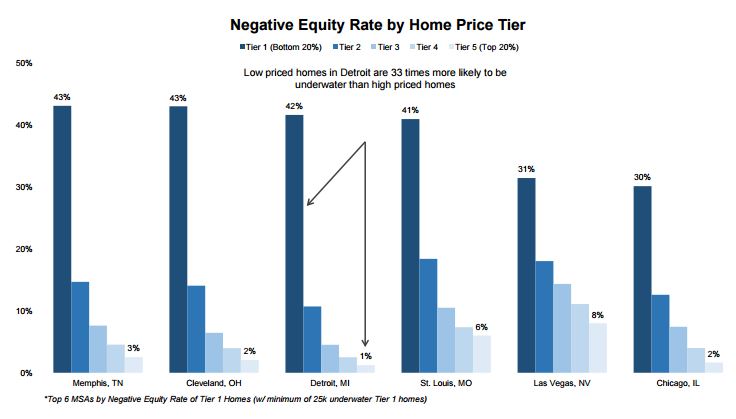 The number of homeowners nationwide with negative equity (a condition commonly known as being “underwater”) has been on the decline for a few years. In 2015, the underwater borrower population dropped by 31 percent, or about 1.5 million borrowers.
The number of homeowners nationwide with negative equity (a condition commonly known as being “underwater”) has been on the decline for a few years. In 2015, the underwater borrower population dropped by 31 percent, or about 1.5 million borrowers.
At the end of 2015, there were 3.2 million underwater borrowers, representing about 6.5 percent of all residential mortgages nationwide—and while negative equity rates have improved overall nationally, the recovery has been imbalanced when it comes to house prices and geography, according to Black Knight Financial Services’ February 2016 Mortgage Monitor released Monday.
According to Black Knight, more than half of underwater homes were in the bottom 20 percent of homes by price in their respective markets. Those 3.2 million underwater borrowers represent approximately $126 billion in first- and second-lien mortgage debt.
“Throughout 2015, the negative equity population in the U.S. decreased by over 30 percent, bringing another 1.5 million homeowners out from underwater on their mortgages,” said Ben Graboske, Black Knight SVP of Data and Analytics. “However, even after four years of improvement, the recovery has not reached all corners. When we looked at the population by home price levels, we found that over half of the nation’s underwater properties are in the lowest 20 percent of their respective markets. That’s the highest share on record. In fact, while the national negative equity rate is now 6.5 percent, for homes in the lowest price tier, it’s over 16 percent. Furthermore, this group is seeing a slower recovery than the nation as a whole. At the current rate of improvement, it would take more than five years for the negative equity rate in this lowest price tier to reach 2005 levels—roughly two-and-a-half years longer than homes in the top 20 percent.”
 Black Knight found the most extreme variance from the high-end to the low-end in Detroit, where lower-priced homes were 33 percent more likely to be underwater than higher-priced homes. The bottom 20 percent of homes are still worth 35 percent less than their value at their peak in 2006, while higher-priced homes in Detroit are worth only 7 percent less than their peak values.
Black Knight found the most extreme variance from the high-end to the low-end in Detroit, where lower-priced homes were 33 percent more likely to be underwater than higher-priced homes. The bottom 20 percent of homes are still worth 35 percent less than their value at their peak in 2006, while higher-priced homes in Detroit are worth only 7 percent less than their peak values.
More than half of all properties that are currently underwater originated during the housing bubble years of 2005 to 2007, according to Black Knight. And while the government’s Home Affordable Refinance Program (HARP) was intended to allow underwater borrowers to refinance their mortgages, only borrowers with GSE-backed mortgages who are current on their loans are eligible for the program.
Click here to view the complete Black Knight February 2016 Mortgage Monitor.

 DSNews The homepage of the servicing industry
DSNews The homepage of the servicing industry










